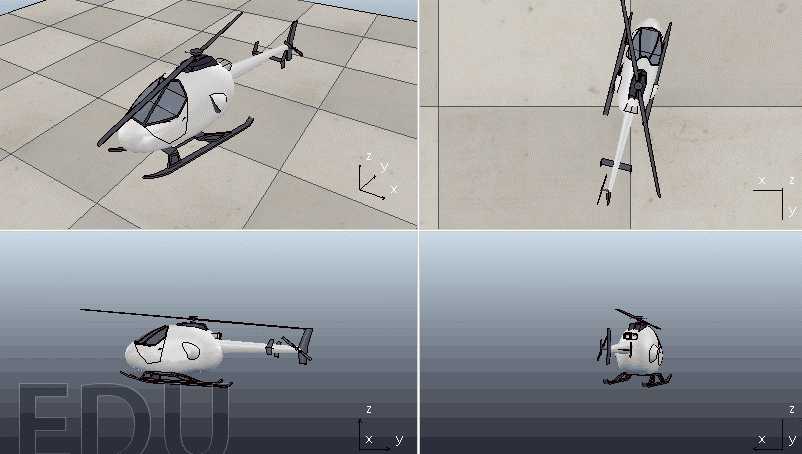标签:bar 分享 seo org 绝对值 orm 反码 判断 res
VREP Regular API提供了串口操作的相关函数,可以对串口进行打开、关闭和读写:

下面使用一款淘宝上常见的AHRS(Attitude and heading reference system,航姿参考系统)模块来驱动VREP中的虚拟模型,控制其姿态。VREP通过串口读取传感器实时发送的数据并进行解析。


传感器通过串口发送2种数据:
下面是VREP中以16进制显示的接收到的串口数据:

根据约定的通信协议,上位机要对接收到的字符串进行解析。关键的一步是要将2个byte型(8位)变量转换为int16型(有符号整型变量,16位),因为角度、高度、温度等数据都可以有正负。
计算机中的符号数有三种表示方法,即原码、反码和补码。三种表示方法均有符号位和数值位两部分,符号位都是用0表示“正”,用1表示“负”,而数值位,三种表示方法各不相同。
以0x8000为例,若用无符号数表达其值为32768,若用有符号数表达其值为-32768。 因为0x8000最高位为1是负数,其代表的值为-(0x7FFF + 1) = -(0x8000) = - 32768(负数的补码求原码和负数的原码求补码的方法一样:除符号位外,每位求反,末位加一)
[+1]原 = 0000 0001
[-1]原 = 1000 0001
[+1] = [00000001]原 = [00000001]反
[-1] = [10000001]原 = [11111110]反
[+1] = [00000001]原 = [00000001]反 = [00000001]补
[-1] = [10000001]原 = [11111110]反 = [11111111]补
补码运算的规则如下。采用补码表示数,在计算机的加、减法运算中,不必判断数的正负,只要符号位参加运算就能自动得到正确的结果。
[ x + y ]补 = x补 + y补
[ x - y ]补 = x补 + [-y]补
将两个2个byte数据转换为int16型的函数如下:
function make_int16(b1, b2) assert (0 <= b1 and b1 <= 0xff) assert (0 <= b1 and b2 <= 0xff) local mask = (1 << 15) local res = (b1 << 8) | (b2 << 0) return (res ~ mask) - mask end
其中mask = (1000 0000 0000 0000)b,将其与res进行异或操作(res~mask)只改变符号位,正数符号位变为1,负数符号位变为0。然后再减去mask,得到res的有符号数。
以0x81和0xC3为例:
res = 0x81<<8 | 0xC3 = (1000 0001 1100 0011)b
res~mask = (0000 0001 1100 0011)b
((res~mask) - mask)补 = (res~mask)补+(-mask )补 = (0000 0001 1100 0011)b补 + (1000 0000 0000 0000)b补 = (1000 0001 1100 0011)b补 = -32317

Lua 5.3开始可以使用“<<”、“~”、“|”等运算符进行移位、取反、或等按位操作,而VREP 3.4中使用的是Lua 5.1还不支持按位操作运算符,可以下载合适的bitwise operation lib,下面使用了LuaBit来完成移位等操作。

代码如下:
require ‘bit‘ make_int16 = function(bh ,bl) assert (0 <= bh and bh <= 0xff) assert (0 <= bl and bl <= 0xff) local mask = bit.blshift(1, 15) -- mask = 1 << 15 local res = bit.bor(bit.blshift(bh,8), bl) -- res = (bh << 8) | bl return bit.bxor(res, mask) - mask -- (res ~ mask) - mask end HelicopterHandle = simGetObjectHandle("Helicopter") --defining the serial port number port = simGetScriptSimulationParameter(sim_handle_self,‘serialPortNumber‘) portNumber = "COM"..port baudrate = 115200 -- Opens a serial port (RS-232) for communication serial = simSerialOpen(portNumber, baudrate) while (simGetSimulationState()~=sim_simulation_advancing_abouttostop) do -- Reads how many bytes are waiting to be read on a serial port --local number =simSerialCheck(serial) -- Reads from a previously opened serial port (RS-232). local str = simSerialRead(serial, 44, true, ‘‘, 1) visibleString = ‘‘ if str ~= nil then for i=1,#str,1 do visibleString = visibleString..string.format("%02X ", string.byte(str,i)) end --simAddStatusbarMessage(visibleString) yaw = make_int16(string.byte(str,5), string.byte(str,6)) pitch = make_int16(string.byte(str,7), string.byte(str,8)) roll = make_int16(string.byte(str,9), string.byte(str,10)) simAddStatusbarMessage(string.format("Yaw:%.1f Pitch:%.1f Roll:%.1f", yaw*0.1,pitch*0.1,roll*0.1)) simSetObjectOrientation(HelicopterHandle, -1, {math.pi/2-pitch*0.1*math.pi/180,-yaw*0.1*math.pi/180,roll*0.1*math.pi/180}) end end -- Closes a serial port (RS-232). Port is automatically closed at simulation stop simSerialClose(serial)
Online Binary-Decimal Converter
How can I convert a pair of bytes into a signed 16-bit integer using Lua?
标签:bar 分享 seo org 绝对值 orm 反码 判断 res
原文地址:http://www.cnblogs.com/21207-iHome/p/7447446.html